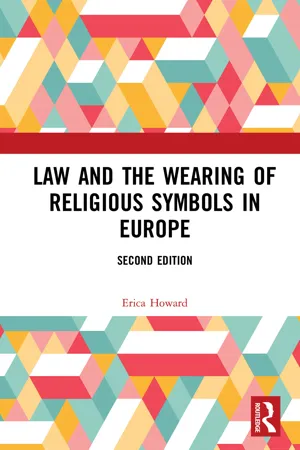Introduction
Before law and the bans on the wearing of religious symbols can be discussed, there are a number of key terms and concepts that need to be examined. First, the meaning of the terms ‘religion’ and ‘belief’, which are often used together in human rights instruments and anti-discrimination legislation,1 will need to be analysed. Second, as this book examines bans on the wearing of religious symbols as a breach of human rights measures, we will discuss the meaning of the fundamental human right to freedom of religion, which includes the right to freedom of thought and conscience, the freedom to change one’s religion or belief, and the freedom, either alone or in community with others and in public or in private, to manifest one’s religion or belief in teaching, practice, worship and observance.2 The wearing of religious symbols can be seen as a manifestation of a person’s religion or belief, and bans are thus claimed to be a violation of the right to manifest one’s religion. The difference between the right to freedom of thought, conscience and religion, on the one hand, and the right to manifest one’s religion or belief, on the other, will also be analysed. As we will be concentrating on Europe, Article 9 of the European Convention for the Protection of Human Rights and Fundamental Freedoms 1950 (ECHR) and the case law of the European Court of Human Rights (ECtHR) – the court established under the ECHR3 – will be central to this analysis.
Third, there is a need to discuss what is meant by ‘religious discrimination’, as this book also examines bans on the wearing of religious symbols as a breach of anti-discrimination measures. Both direct and indirect religious discrimination will be defined in this chapter. Fourth, the term ‘religious symbols’, and in what way these are distinguishable from other symbols, such as, for example, political symbols, needs to be discussed. Religious symbols as well as political symbols could both play a role within, for example, the workplace and in educational establishments: should an employee, a teacher or pupil be prohibited from wearing a clear sign of affiliation to a (mainstream or extreme) political party, to creationism or to human rights or environmental campaign groups? The first terms to be examined are ‘religion’ and ‘belief’.
1 As in the title of the 1981 UN Declaration on the Elimination of All Forms of Intolerance and of Discrimination Based on Religion or Belief; in Directive 2000/78/EC, which prohibits discrimination on the grounds of religion or belief; in Section 4 of the British Equality Act 2010 (EA 2010), where ‘religion or belief’ is mentioned as one of the characteristics protected by the Act.
2 See, for example: Article 18 United Nations’ Universal Declaration of Human Rights 1948; Article 18 International Covenant on Civil and Political Rights 1966; Article 9 ECHR.
3 The ECHR established a European Commission of Human Rights (ECnHR) as well as the ECtHR. Protocol 11 to the ECHR, which came into force in 1998, abolished the Commission, enlarged the ECtHR and allowed individuals to take cases directly to the ECtHR. The case law from the Commission from before 1998 will be referred to where relevant.
